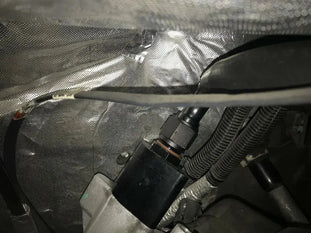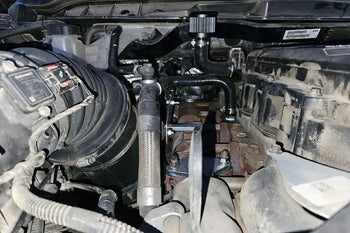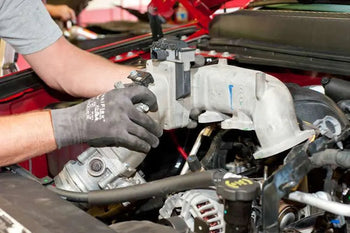What Does an EGR ...
Aug 09, 2025
The crankcase ventilation (CCV) system on the 6.7L Cummins plays a vital role in managing blow-by gases and maintaining proper crankcase pressure. However, the factory design often results in excessive pressure build-up, oil consumption and turbo contamination. This article details actual pressure testing of a stock CCV system, identifies key restriction points, and explains why CCV redirection or PCV redirection is often necessary for optimal engine performance and longevity. Why Test CCV System Pressure? Excessive crankcase pressure can cause: · Oil leaks (seals, gaskets, turbo feed lines) · Increased oil consumption (blow-by carrying oil into intake) · Turbocharger contamination (oil coking on compressor wheel) · Reduced engine efficiency (higher crankcase pressure = more parasitic loss) By measuring pressure at different points in the system, we can pinpoint where restrictions occur and determine the best solution—whether that’s a CCV reroute kit, a catch can, or a complete redesign. Testing Methodology We conducted pressure tests on a stock 6.7L Cummins using: · Digital manometer (measuring in inches of water column, "H₂O) · Pressure taps at critical locations: o Valve cover outlet (pre-CCV restriction) o Post-CCV hose (before turbo inlet) o Crankcase dipstick tube (baseline pressure) Tests were performed at:✔ Idle (700 RPM)✔ Mid-load (2,000 RPM, light throttle)✔ High-load (WOT, 3,000+ RPM) Key Findings: Where the Stock CCV System Fails 1. Excessive Crankcase Pressure at Higher RPM · Idle: ~1.5" H₂O (acceptable) · 2,000 RPM: ~4.2" H₂O (approaching problematic) · WOT: 8-10" H₂O (far beyond ideal) Why It Matters: · Pressures above 4-5" H₂O can force oil past seals and into the intake. · At WOT, the stock system cannot evacuate blow-by efficiently. 2. Major Restriction: Factory CCV "Rooster Comb" Baffle The stock Cummins CCV system uses a "rooster comb" baffle inside the valve cover to separate oil from blow-by gases. Testing revealed: · Pressure drop across baffle: ~3.5" H₂O at high RPM · Oil carryover: Significant mist still reaches the turbo inlet Problem: The factory baffle is too restrictive and doesn’t separate oil effectively. 3. Turbo Inlet Contamination Risk · Post-CCV testing showed oil mist accumulation in the intake piping. · Over time, this leads to turbo coking and intercooler clogging. The Solution: CCV Reroute or Performance Baffle Upgrade Since the stock system is restrictive and inefficient, there are two proven fixes: Option 1: Full CCV Reroute (Vented or Catch Can) · Eliminates intake contamination by venting to atmosphere or a catch can. · Reduces crankcase pressure to safe levels (<3" H₂O at all RPMs). · Best for modified/high-performance engines where blow-by is increased. Option 2: High-Flow Baffle Upgrade · Replaces restrictive "rooster comb" with a better-flowing design. · Improves oil separation while maintaining emissions compliance. · Good for stock/near-stock trucks where rerouting isn’t desired. Performance Gains from a Proper CCV Solution ✔ Reduced oil consumption (less blow-by oil loss)✔ Cleaner turbo & intercooler (no more oil coking)✔ Longer engine life (less pressure on seals/gaskets)✔ Better throttle response (reduced crankcase pumping losses) Upgrade Your CCV System Today If your 6.7L Cummins is suffering from excessive crankcase pressure or oil consumption, a CCV reroute kit is the proven solution. Check out our high-performance CCV/PCV Reroute Kits to optimize your engine’s breathing and reliability.
The crankcase ventilation (CCV) system, also known as the positive crankcase ventilation (PCV) system, plays a vital role in maintaining engine health by managing blow-by gases. However, poor design can result in excessive oil consumption, turbo contamination and reduced engine efficiency. This article explores how Venturi effect dynamics and baffle engineering affect oil separation, and how CCV redirection or PCV redirection can optimize performance in modern diesel engines. The Role of the CCV/PCV System The CCV system prevents pressure build-up in the crankcase by rerouting blow-by gases back into the intake for combustion. However, if these gases are not properly controlled they can lead to oil mist, which: · Coat turbocharger wheels, reducing efficiency · Clog intercoolers, increasing intake air temperatures · Contaminate sensors, causing drivability issues Venturi Effect: How It Enhances Oil Separation Many high-performance CCV systems take advantage of the Venturi effect – a fluid dynamics principle in which the velocity of a gas increases as it passes through a constricted section, causing a reduction in pressure. Key Benefits of Venturi-Based CCV Systems Improved Oil Mist Capture – The low-pressure zone helps separate oil droplets from blow-by gases.Reduced Turbo Contamination – Less oil ingestion means cleaner compressor wheels and intercoolersLower Crankcase Pressure – Efficient evacuation minimizes oil leaks and seal failures. Baffle Design: The Unsung Hero of Oil Separation An effective baffle system inside the valve cover or CCV housing ensures that oil droplets are trapped before entering the intake. Critical Baffle Design Features · Multi-Stage Filtration – Mesh screens, centrifugal separators, and impact surfaces maximize oil capture. · Drainback Channels – Collected oil must return efficiently to the crankcase to prevent pooling. · Heat Resistance – High-quality materials prevent warping under extreme temperatures. Why a CCV Reroute or PCV Reroute is Often Necessary Factory CCV systems are often undersized or poorly routed, leading to: · Excessive oil consumption · Turbo oil coking · EGR and intake clogging A high-quality CCV reroute kit solves these issues by:Relocating the vent path (e.g., to atmosphere or a catch can)Incorporating advanced baffling for superior oil separationReducing intake tract contamination Performance & Longevity Benefits of an Optimized CCV System · Cleaner Turbo & Intercooler – Prevents oil buildup that restricts airflow. · Stable Crankcase Pressure – Reduces risk of leaks and seal failures. · Improved Engine Efficiency – Less oil burn means better combustion consistency. Upgrade Your CCV System Today If your engine suffers from excessive oil consumption or turbo contamination, a PCV/CCV reroute could be the solution. Check out our selection of high-performance CCV/PCV Reroute Kits to optimize your engine’s breathing.
The Jeep EcoDiesel platform, particularly the 3.0L V6 found in the Grand Cherokee and Ram 1500, has drawn considerable attention for its balance of torque, fuel efficiency, and off-road capability. However, like many modern diesel engines, it comes equipped with restrictive emissions control systems that, while environmentally necessary, often reduce reliability and limit performance potential. As a result, many owners ask: Can you delete a Jeep EcoDiesel? The answer is nuanced, involving mechanical feasibility, legal considerations, and performance outcomes. This article explores the concept of deleting a Jeep EcoDiesel engine, focusing on EGR and DPF delete kits and the role of tuners in the process. Understanding What “Deleting” Means To “delete” a diesel engine refers to the removal or bypassing of factory-installed emissions components, such as the Exhaust Gas Recirculation (EGR) system, Diesel Particulate Filter (DPF), Diesel Exhaust Fluid (DEF) system, and Selective Catalytic Reduction (SCR) systems. These components are designed to meet stringent EPA regulations but can become problematic in terms of long-term reliability, fuel economy, and engine performance. Deleting these systems involves both physical removal—via parts like EGR block-off plates or DPF race pipes—and software recalibration using a performance tuner to prevent check engine lights and limp mode. Why Do Owners Consider Deleting a Jeep EcoDiesel? Owners consider deleting their EcoDiesel engines for several reasons: Performance Restoration: Emissions systems restrict exhaust flow and introduce recirculated soot into the engine, hampering horsepower and torque. Improved Fuel Economy: Once these systems are removed, fuel combustion becomes more efficient, often leading to measurable MPG gains. Engine Longevity: The EGR system can lead to carbon buildup in the intake manifold and valves. Removing it reduces long-term wear. Avoiding Costly Repairs: Replacing failed emissions components can be expensive—EGR coolers, DPF filters, and DEF pumps are prone to failure over time. Legal Considerations: What You Need to Know Before proceeding with a delete, it is critical to understand the legal landscape. In the United States and many other regions, deleting emissions systems on street-driven vehicles is illegal under federal law, particularly the Clean Air Act. The EPA has increased enforcement in recent years, issuing heavy fines to individuals and shops who tamper with emissions systems for road use. Therefore, EGR and DPF delete kits are intended only for off-road, race, or competition-use vehicles that are not registered for highway operation. Using them on public roads could result in legal penalties, emissions test failures, and denied warranty claims. What Is Involved in Deleting a Jeep EcoDiesel? Successfully deleting a Jeep EcoDiesel engine requires a coordinated installation of hardware and software components. These typically include: 1. EGR Delete Kit The EGR delete kit removes or disables the EGR valve and cooler. This prevents exhaust gases from re-entering the intake tract, thereby improving combustion efficiency and reducing soot buildup. Benefits: Cleaner intake system Lower exhaust gas temperatures Reduced chance of EGR cooler failure 2. DPF Delete Pipe The DPF delete involves replacing the restrictive particulate filter with a straight or free-flowing exhaust pipe. This eliminates backpressure and prevents regeneration cycles. Benefits: Noticeable horsepower and torque gains Elimination of DPF-related warning lights Reduced exhaust gas temperatures 3. DEF and SCR Delete Though less common, some setups also include the removal of the DEF tank and SCR catalyst, particularly in race applications. Benefits: Reduced weight Simpler maintenance Fewer system faults The Role of a Tuner in the Delete Process No delete is complete without proper tuning. A tuner reprograms the vehicle's ECM (Engine Control Module) to disable the sensors and alerts related to the emissions systems. One popular choice among diesel performance enthusiasts is the EZ LYNK Auto Agent 3. EZ LYNK Auto Agent 3: Tuning Made Easy This cloud-based tuner offers: Emissions-delete tuning support Real-time diagnostics and monitoring Live technician support Custom power levels and throttle response settings Once installed, the tuner ensures that the deleted systems will not trigger fault codes, emissions warnings, or limp mode. It also allows the user to optimize fueling and boost parameters for enhanced performance. Can You Delete It Yourself? Technically, yes. With the right tools, mechanical knowledge, and access to delete parts and a tuner, a skilled DIY enthusiast can complete a Jeep EcoDiesel delete in a weekend. However, tuning software must be used correctly to avoid damaging the ECM or voiding critical functions. For those less confident in their abilities, professional diesel performance shops offer installation services—again, only for off-road applications. Performance Results After Deleting Once deleted and tuned, many owners report: Horsepower gains of 30–60 HP Torque increases of up to 100 lb-ft Fuel economy gains of 2–5 MPG Reduced turbo lag and smoother throttle response Improved towing performance These benefits make the delete appealing for trucks used in farming, hauling, or off-road racing scenarios where reliability and power are paramount. Risks and Considerations Deleting a vehicle is not without potential downsides: Warranty Voids: Any delete will almost certainly void your powertrain warranty. Inspection Failures: Your Jeep will not pass emissions testing in states or countries that require it. Resale Complications: A deleted vehicle may have limited resale value unless the buyer intends to use it for off-road purposes. Final Thoughts: Is It Worth It? So, can you delete a Jeep EcoDiesel? Technically, yes—for off-road or race use only. The process involves removing emissions systems like the EGR and DPF and reprogramming the ECM with a compatible tuner such as the EZ LYNK Auto Agent 3. The results can be impressive: better fuel economy, stronger towing performance, and fewer maintenance headaches. However, it is crucial to weigh the legal, environmental, and financial risks. If you decide to pursue this route, make sure your vehicle will only be used in settings where emissions regulations do not apply, such as private property, sanctioned competitions, or off-road events. Recommended Product: DynoVox 3.0L EcoDiesel Delete Kit If you are ready to unleash your Jeep’s full potential in off-road conditions, consider the DynoVox 3.0L EcoDiesel EGR + DPF Delete Kit. This all-in-one solution includes: EGR Valve and Cooler Delete Kit DPF Race Pipe Optional EZ LYNK Auto Agent 3 for tuning DynoVox kits are engineered for durability, perfect fitment, and maximum performance—making them the preferred choice for serious diesel enthusiasts. FAQS: 1. What is a delete kit for the Jeep EcoDiesel?A delete kit is a performance modification that removes emissions components like the EGR (Exhaust Gas Recirculation) system, DPF (Diesel Particulate Filter), and sometimes the DEF system, improving power and reliability. 2. Is it legal to delete the emissions system on a Jeep EcoDiesel?No, deleting emissions components on a street-driven vehicle violates federal EPA regulations in the United States. Delete kits are intended for off-road or competition use only. 3. What are the benefits of deleting a Jeep Grand Cherokee EcoDiesel?Deleting the EcoDiesel can improve horsepower, torque, fuel economy, reduce soot buildup, and eliminate frequent regeneration cycles. 4. Do I need a tuner if I delete the EGR and DPF on my EcoDiesel?Yes, a tuner such as the EZ Lynk Auto Agent 3 is required to recalibrate the ECM, disable regeneration codes, and ensure the engine runs properly after the delete. 5. Will deleting my EcoDiesel void the factory warranty?Yes, any emissions-related modification, including EGR and DPF deletes, will void your powertrain and emissions warranty. 6. Can deleting the EGR/DPF system damage the EcoDiesel engine?When done properly with the right tune, deletes often improve engine longevity by reducing carbon buildup and heat stress. Improper deletes, however, can cause engine issues. 7. How much horsepower can I gain from deleting a Jeep EcoDiesel? Many users report gains of 30–50 horsepower and significant torque improvement when deleting the EGR and DPF systems combined with tuning. 8. What parts are included in a typical EcoDiesel delete kit?A full delete kit generally includes a DPF delete pipe, EGR block-off plates, a coolant reroute hose, and a compatible tuner to flash the ECM. 9. How long does it take to install an EcoDiesel delete kit?Installation time varies by experience but typically takes 4–6 hours with proper tools and workspace. 10. Is it safe to drive an EcoDiesel without the DPF and EGR systems?For off-road use, it is generally safe when a quality tune is applied. The engine often runs cleaner and more efficiently post-delete.
The 2007.5-2010 LMM Duramax 6.6L engine is a powerful engine, but its exhaust gas recirculation (EGR) system - specifically the EGR cooler - is a well-known weak point. EGR-related failures can lead to costly repairs, reduced engine efficiency, and even catastrophic damage. This article explores the common failure modes of the EGR cooler in the LMM Duramax and explains why an EGR delete kit is a proven solution for improved reliability and performance. Common EGR Cooler Failure Modes in the LMM Duramax 1. Cooler Cracking and Exhaust Gas Leaks EGR coolers are subjected to excessive thermal cycling, resulting in metal fatigue and eventual cracking. A broken cooler can release exhaust gases, reducing efficiency and contaminating the cooling system. 2. Coolant Contamination When the EGR cooler fails internally, exhaust gases can put pressure on the cooling system, causing loss of coolant, overheating, and possible head gasket failure. Clear signs of this problem are milky oil or coolant found in the intake. 3. Carbon Buildup and Restricted Flow Soot-laden exhaust gases are recirculated through the EGR system, causing heavy carbon deposits in the intake manifold, valves, and cooler passages. This restricts airflow, reduces power, and increases turbo lag. 4. Increased Engine Temperatures A blocked or malfunctioning EGR cooler prevents proper heat exchanger, causing EGT (exhaust gas temperature) to rise and increase stress on engine components. Why an EGR Delete Kit is the Optimal Solution Deleting the EGR system eliminates these failure points while providing several key benefits: · Improved Engine Longevity – Removing the EGR cooler prevents coolant contamination, carbon buildup, and exhaust gas leaks. · Enhanced Performance – Without restrictive EGR flow, the engine breathes better, improving throttle response and turbo efficiency. · Reduced Maintenance Costs – No more EGR cooler replacements, coolant flushes, or intake cleanings. · Lower EGTs – A deleted EGR system reduces heat soak, helping maintain optimal engine temperatures. Key Components of an Effective EGR Delete Solution A complete 6.6L Duramax EGR delete kit should include: · High-Flow Intake Elbow – Replaces the restrictive factory elbow for improved airflow. · High-Flow Intake Pipe – Ensures smooth, unobstructed air delivery to the turbo. · Block-Off Plates – Seals the EGR ports to prevent exhaust gas recirculation. · Durable Gaskets & Hardware – Ensures a leak-free, long-lasting installation. For those looking to maximize their LMM Duramax’s potential, pairing an EGR delete with a performance intake elbow pipe and upgraded intake tube further enhances airflow and efficiency. Final Thoughts The LMM Duramax's EGR cooler is a liability waiting to fail. By installing a Duramax EGR Delete Kit, owners can eliminate this weak point while gaining improved performance, reliability and efficiency. Whether daily driving or heavy towing, the EGR deletion is one of the best performance parts for the 6.6L Duramax. Upgrade Your LMM Duramax Today Ready to eliminate EGR-related headaches? Check out our high-quality 6.6L Duramax EGR Delete Kit and other Duramax performance upgrades for a stronger, more reliable engine.
If you own a 2004-2010 6.6L Duramax (LLY, LBZ, or LMM), you’ve likely heard about the CCV (Crankcase Ventilation) system and its impact on engine longevity. Over time, the factory CCV/PCV setup can contribute to oil contamination, turbo wear, and even reduced performance. Fortunately, a CCV/PCV reroute or delete kit can help mitigate these issues—extending the life of your Duramax while improving efficiency. Why the Factory CCV System Can Be a Problem The stock CCV/PCV system on the 6.6L Duramax recirculates blow-by gases (containing oil vapor, fuel, and combustion byproducts) back into the intake. While this design meets emissions standards, it has several downsides: - Oil Contamination – The oily mist can coat your intercooler, intake manifold, and turbo, reducing efficiency. - Carbon Buildup – Over time, deposits can accumulate in critical components, leading to clogs and poor performance. - Turbocharger Wear – Excess oil vapor can cause premature wear on turbo seals. How a CCV Reroute or Delete Kit Helps A CCV/PCV reroute or delete kit (like our CCV/PCV Reroute Delete Kit for 2004-2010 6.6L LLY LBZ LMM Duramax) redirects these harmful gases away from your intake system. Instead of recirculating them, the kit vents them to the atmosphere or filters them through a catch can. Key Benefits of a CCV Reroute/Delete: - Reduces Oil Contamination – Keeps your intake and turbo cleaner for better airflow and efficiency. - Extends Turbo Life – Less oil exposure means fewer seal failures. - Improves Engine Performance – Cleaner air intake leads to more consistent power delivery. - Easy Installation – Most kits bolt on in under an hour with basic tools. Choosing the Right CCV Reroute Kit When selecting a Duramax CCV delete kit, look for: - Durable Materials – High-quality aluminum or steel fittings resist heat and corrosion. - Proper Venting – Ensures crankcase gases are safely expelled without causing oil leaks. - Compatibility – Make sure the kit fits your specific LLY, LBZ, or LMM Duramax model. Our CCV/PCV Reroute Delete Kit is designed for 2004-2010 6.6L Duramax engines, offering a simple and effective solution to protect your engine. Final Thoughts If you want to maximize the lifespan of your 6.6L Duramax, a CCV reroute or delete is a smart upgrade. By preventing oil buildup and reducing turbo wear, you’ll keep your engine running stronger for longer. 👉 Check out our CCV/PCV Reroute Delete Kit today and give your Duramax the protection it deserves!
The 6.7L Cummins engine has earned its reputation as one of the most durable and high-performing diesel platforms available on the market. Its widespread use in heavy-duty Ram trucks has made it a staple among fleet operators, towing professionals, and performance enthusiasts. While its core mechanical architecture is robust, certain emissions-related subsystems—such as the factory Crankcase Ventilation (CCV) system—pose long-term risks to engine efficiency, cleanliness, and operational stability. One often overlooked modification that has a measurable impact on the 6.7L Cummins is the CCV reroute. While not as attention-grabbing as performance tuners or turbo upgrades, the rerouting of crankcase gases offers tangible, long-term benefits that directly affect engine longevity and operational precision. This article explores the intricate role of the CCV system, the limitations of its stock configuration, and the multi-dimensional advantages of a properly engineered reroute. Understanding the Function of the CCV System The CCV system, or Crankcase Ventilation system, is designed to manage the blow-by gases generated during the combustion cycle. As pressure builds within the crankcase due to minor combustion leakage past piston rings, it becomes necessary to vent these gases to maintain pressure equilibrium and prevent oil seal damage. In the stock 6.7L Cummins configuration, these crankcase gases—laden with oil mist and unburned hydrocarbons—are rerouted back into the intake tract. This method is implemented primarily for emissions control, as it allows the vapors to be reburned during combustion. However, while effective for meeting EPA regulations, this solution introduces a host of mechanical inefficiencies and contamination risks. Hidden Consequences of Recirculating Blow-By Gases The gases expelled from the crankcase are not inert. They are a complex mixture of oil vapor, fuel residues, combustion byproducts, and moisture. When these elements are routed back into the intake system, several issues begin to manifest: Oil Film Accumulation: Thin layers of oil coat the intake piping, throttle valve, and intercooler. This not only restricts airflow but also creates a sticky substrate for dust and soot particles to adhere to. Carbon Build-Up: In engines that also utilize an Exhaust Gas Recirculation (EGR) system, the combination of soot and oil mist leads to hardened carbon buildup. This drastically reduces volumetric efficiency and can choke airflow through the intake manifold. Sensor Contamination: Mass airflow sensors, MAP sensors, and throttle actuators are prone to failure when subjected to prolonged oil vapor exposure. Turbo Efficiency Loss: The turbocharger’s compressor wheel is particularly sensitive to oil vapor. Coating the fins with residue affects balance, spool rate, and long-term bearing health. While these consequences do not immediately disable the engine, their cumulative effect is a gradual but persistent degradation in performance, fuel economy, and reliability. How a CCV Reroute Solves These Issues A CCV reroute addresses the above concerns by redirecting crankcase gases away from the intake system and venting them through a separate, filtered outlet—often externally. This modification, though conceptually simple, has profound effects on engine cleanliness and stability. 1. Preserves Intake System Integrity The removal of oil-laden gases from the intake pathway ensures that no film or residue builds up over time. This helps maintain consistent airflow velocity, preserve sensor accuracy, and prevent premature failure of throttle bodies or EGR components. In practical terms, the engine breathes cleaner air, combustion is more stable, and the intake components remain cleaner even after tens of thousands of miles. 2. Reduces Turbocharger Contamination By preventing oil vapor from reaching the turbo inlet, a CCV reroute safeguards one of the engine’s most expensive and sensitive components. A clean compressor wheel maintains its aerodynamic properties, ensuring that turbo boost levels remain consistent and efficient. This is particularly crucial for engines subjected to high-load applications like towing or high-altitude driving. 3. Lowers Maintenance Costs and Intervals Contaminated intercoolers, fouled sensors, and EGR-related service are common and costly. A CCV reroute significantly delays, and in many cases eliminates, the need for such service. This translates to longer intervals between deep cleanings, fewer diagnostic issues, and more predictable maintenance planning for owners. 4. Improves Engine Longevity Through Cleaner Combustion Cleaner intake air leads to more complete combustion, especially under high cylinder pressures. The removal of oil mist eliminates the risk of pre-ignition caused by volatile hydrocarbons entering the combustion chamber. Over time, this helps preserve piston ring sealing integrity, cylinder wall condition, and oil quality—each of which contributes to engine life. 5. Minimizes Regeneration Frequency in DPF-Equipped Engines Though indirect, one valuable benefit of a CCV reroute is the reduction in particulate matter entering the exhaust system. When oil is burned alongside diesel fuel due to crankcase vapor recirculation, it produces more soot, which accelerates the clogging of the diesel particulate filter (DPF). Cleaner combustion means fewer regeneration cycles and extended DPF service intervals. Recommended Product: DynoVox 6.7L Cummins CCV/PCV Reroute Kit For 2007–2023 Dodge Ram owners seeking to eliminate oil mist buildup and protect turbo efficiency, the DynoVox CCV/PCV Reroute Kit is a reliable solution. Designed specifically for the 6.7L Cummins, it improves engine ventilation, reduces carbon deposits, and supports long-term performance. Easy to install and built to last. Shop the 6.7L Cummins CCV Reroute Kit Now Technical Considerations Before Implementation While the advantages are compelling, it is important to ensure that the reroute is done correctly. Improper venting may allow moisture or oil to pool around the engine bay. In colder climates, expelled vapors can condense and freeze, causing blockages if not properly filtered or routed downward. Therefore, any CCV reroute should be accompanied by a high-quality filter or catch-can system and be designed to prevent backpressure. Additionally, reroutes may be subject to regulatory scrutiny in some jurisdictions. As with any emissions-related modification, vehicle owners must ensure that they remain compliant with local laws if the truck is intended for on-road use. Conclusion The 6.7L Cummins engine is a highly capable and respected platform, but its factory CCV system introduces vulnerabilities that can compromise performance and increase maintenance costs over time. By implementing a CCV reroute, owners can proactively protect critical components such as the turbocharger, intake manifold, and intercooler. This single modification offers a layered benefit structure—improving engine hygiene, stabilizing combustion quality, and reducing service frequency. When viewed from a long-term ownership perspective, the CCV reroute is not just a niche upgrade; it is a calculated step toward preserving mechanical integrity and maximizing return on investment in a diesel engine platform. For those seeking to optimize every aspect of their 6.7L Cummins engine—from throttle response to overall system cleanliness—the CCV reroute is not optional. It is essential. Frequently Asked Questions (FAQs) 1. What does a CCV system do on a 6.7L Cummins engine?The CCV system (Crankcase Ventilation) routes blow-by gases from the crankcase back into the intake, reducing emissions but potentially introducing oil vapor into the air intake system. 2. Why should I consider a CCV reroute for my 6.7L Cummins?A CCV reroute helps prevent oil vapor from contaminating the intake manifold and turbocharger, reducing carbon buildup and improving long-term engine reliability. 3. Does a CCV reroute improve fuel economy on the 6.7L Cummins?Yes, many drivers notice slight improvements in fuel economy due to cleaner combustion and more efficient turbo operation after installing a CCV reroute. 4. Will a CCV reroute lower maintenance costs?Absolutely. By keeping oil out of the intake and turbo system, a CCV reroute can help extend the life of key components and reduce the need for frequent cleaning or part replacement. 5. Is a CCV reroute legal for on-road use?Legality varies by region. While CCV reroutes are often used for off-road or racing applications, users should verify compliance with local emissions regulations. 6. Can I install a CCV reroute kit myself on a 6.7L Cummins?Yes, most CCV reroute kits are designed for DIY installation with basic tools. However, professional installation is recommended if you're unfamiliar with engine components. 7. What are the signs that I need a CCV reroute?Excessive oil in the intercooler piping, sluggish turbo response, or visible oil vapor in the intake system are common signs indicating the need for a reroute. 8. Does a CCV reroute affect engine warranty?Modifying the CCV system may affect your engine warranty. It is important to check with your manufacturer or dealer before performing any modifications. 9. How often should I service a CCV reroute system?Unlike the factory CCV setup, reroute systems generally require less maintenance. Occasional inspection of hoses and fittings is sufficient for most setups. 10. Will a CCV reroute improve engine performance on its own?While it may not drastically increase horsepower, a CCV reroute enhances performance by improving airflow efficiency and protecting the turbo from oil-related issues.
Aug 09, 2025
Aug 07, 2025
Aug 01, 2025





